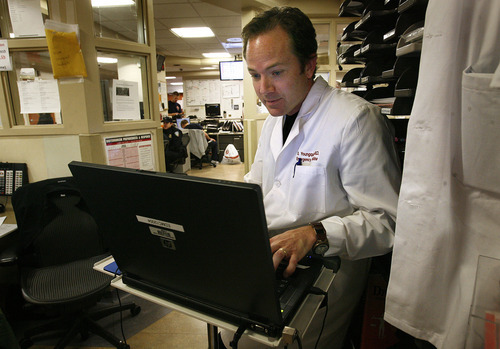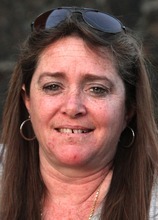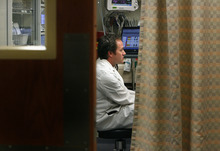This is an archived article that was published on sltrib.com in 2012, and information in the article may be outdated. It is provided only for personal research purposes and may not be reprinted.
Scott Youngquist is trained to save lives, not pull teeth.
But rarely does the emergency-room doctor end a 12-hour shift at University Hospital without seeing at least one dental complaint — from cavities to abscesses requiring drainage and IV antibiotics.
"We're seeing more of it all the time," he says.
It is a national problem spotlighted Feb. 26 in a report by the Pew Center on the States.
Emergency rooms in Utah hospitals treated 4,786 people in 2009 for cavities, toothaches and other woes that could have been avoided with routine check-ups, according to a Pew analysis of federal hospital data. That's a 21 percent increase from 2006.
Nationally, dental-related ER visits are up 16 percent — "eye-popping" evidence of the dental system's failure to meet the country's oral health needs, said Shelly Gehshan, director of the Pew Children's Dental Campaign.
Utah pales in comparison to states like Florida, which had more than 115,000 decay-related ER visits in 2010. California had 83,000. But the consequences for patients and policy makers here are the same.
ERs are not the place to find lasting relief from tooth pain. You probably will get a prescription for pain medication or antibiotics, and nothing more, said Gehshan.
"It's the wrong service in the wrong place at the wrong time for people who have nowhere else to go," she said.
Emergency departments also are an expensive source for treatment, a cost borne in part by taxpayers.
About a third — 28 percent — of the Utahns visiting ERs in 2009 for preventable dental problems were low-income patients on Medicaid, many of them children. That's according to a separate analysis of state data by The Salt Lake Tribune, using the Pew Center's formula.
The total cost of those visits, which may include other care given to those patients, was just under $1 million.
Gehshan said there is a lot states can, and should, do to remedy the problem, including plugging holes in Medicaid dental coverage and giving dentists financial incentives to treat under-served patients.
In Utah, all adults on Medicaid, except pregnant women, lost their dental coverage to budget cuts in 2009.
Since she enrolled in Medicaid two years ago, Kari Sawatzki's dental problems have gotten worse, not better.
The 47-year-old Salt Lake City woman says she has holes in most of her teeth. Three are broken and three had to be pulled.
Eating meats and hard fruits like apples is out of the question, limiting her food choices beyond what her $387-a-month budget will allow, and complicating her diabetes.
She was able to get help once at a free clinic but that was years ago. Her husband, also on Medicaid, sought help once at an ER and was turned away.
Brushing her teeth is "agonizing" and she avoids smiling. "It's hard to talk. People think I have a speech impediment and stare at me," she says.
She believes if she had better teeth it would be easier for her to find work.
The Utah Department of Health is considering providing emergency dental services in the hopes of showing they can save money by reducing ER visits.
Kids on Medicaid have dental coverage. But a recent survey showed only 150 of Utah's 1,006 practicing dentists care for Medicaid patients, due to the program's low payments.
For many low-income children, a trip to the ER is their first brush with dental care, said Rep. Tim Cosgrove. The Murray Democrat is sponsoring legislation, HB125, to create a college loan repayment program for dentists who work in rural areas, do charity care and take Medicaid patients.
The problem is bigger, though, than the dentist shortage.
Young adults, between the ages 20 and 29, were the heaviest users of ERs for dental care, The Tribune found.
They also are more likely to be uninsured; 40 percent of all dental-related ER visits were by Utahns with no dental coverage who either paid cash or qualified for charity care.
State Dental Director Steven Steed called it a "frustrating," multifaceted problem made worse by "the cultural point of view that you wait until it hurts."
Dental care often is perceived as a nice-to-have luxury, though ample studies have linked poor oral health with heart disease and other ailments.
A state survey in 2011 showed more than half of Utah children ages 6 to 9 have had tooth decay, which can lead to pain, infection, problems with eating and difficulty learning.
"Education is a key part of this, which is why we've been trying to encourage pediatricians to include oral health as part of their well-child visits," said Steed, noting that charitable clinics alone can't shoulder the burden.
Youngquist has talked with his peers about training ER residents to pull teeth.
Preserving them with caps and fillings is preferable, but in some cases and with some patients, extractions "would be a nice service" to provide, said Youngquist.
Nothing legally bars emergency doctors from doing that now. Unlike with other specialties, where regulations dictate the types of procedures doctors can and can't do, emergency medicine is defined by its location.
"It's a specialty that adapts to the needs of patients, which changes as the health care system evolves," said Youngquist, noting how emergency physicians have trained themselves to operate diagnostic ultrasound devices because technicians weren't available at night.
But the idea of yanking teeth hasn't gotten much support — "mainly because of the historical separation between dentistry and medicine, the fear of lawsuits and the lack of a clear pathway for follow up care," Youngquist said.
Meanwhile, patients will continue to seek relief from pain.
"The path of least resistance has historically been the emergency department," said Youngquist, "which is open 24/7, never turns anyone away, and usually finds a way to get you the help you need."
kstewart@sltrib.comTwitter: @kirstendstewart —
Editor's note
The Salt Lake Tribune identified preventable dental conditions by searching the Utah Emergency Department Encounter Database for patients with a primary diagnosis of 521 or 522. These International Classification of Diseases (ICD-9) codes were chosen by the Pew Center on the States in consultation with Frank A. Catalanotto, a dentist and Chairman of the Department of Community Dentistry and Behavioral Science at the University of Florida's College of Dentistry.







